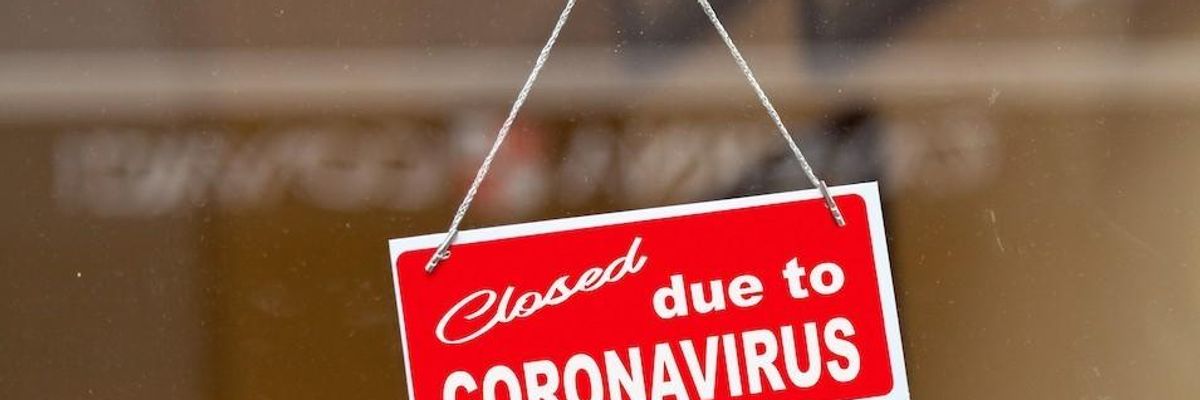
Red sign hanging at the glass door of a shop says, "Closed due to coronavirus." (Photo: Getty Images)
In the Last Four Weeks, More Than 20 Million Workers Applied for Unemployment Insurance Benefits
Congress has the power to dramatically mitigate the suffering associated with the coronavirus shock, and they have an obligation to exercise it.
Correction: This post has been updated to show that 69% of the new UI filers were receiving benefits. An earlier version said 73%.
In the last four weeks, 20.1 million people --more than one in eight workers--applied for unemployment insurance (UI) benefits. This is more than a 2,200% increase over the pre-virus period and averages out to almost three-quarters of a million new jobless claims every day for nearly a month. The 20.1 million jobless claims in the last four weeks are more than five times the worst four-week stretch of the Great Recession.
I should note that I am not using seasonally adjusted numbers here. Seasonal adjustments are typically used to even out seasonal changes in claims that have nothing to do with the underlying strength or weakness of the labor market. However, the way the Department of Labor (DOL) does seasonal adjustments is somewhat distortionary at a time like this (DOL reported that 22.0 million workers filed for unemployment insurance claims over the last four weeks on a seasonally adjusted basis). To avoid these issues, I am citing the unadjusted numbers, since they reflect the actual number of initial claims.
But what share of workers who applied for UI in this pandemic are actually receiving benefits? The data to answer that are lagged a week, but it looks like roughly 69% are getting benefits. That is calculated from noting that between March 14 and April 4, the total number of workers receiving benefits (known as "continued claims" or "insured unemployment") increased by 10.5 million. Over the same period, 15.1 million workers filed unemployment insurance claims. That means that by April 4th, only roughly 10.5 million out of 15.1 million, or 69% of new filers, were receiving benefits.
Job losses of the magnitude reflected in the UI numbers of the last four weeks would translate into an unemployment rate of more than 15%. However, the official unemployment rate for April--when it is released on May 8th--may not reflect that because jobless workers are only counted as unemployed if they are actively seeking work, which is impossible right now for many.
We don't have breakdowns of UI numbers by race and ethnicity, but because black and Hispanic workers are more concentrated in front-line service jobs that have been hit hard by social distancing, black and Hispanic people are likely experiencing greater job loss. We do however have initial data on job loss by gender, and it shows that women have been hit harder by job loss than men. And of course, workers aren't just losing their jobs. Our health care system ties health insurance to work, so millions of workers likely lost their employer-provided health insurance at the end of March, and millions more will likely follow this month and coming months.
It is important to note that the extraordinary UI claims of the last month don't include people who aren't eligible for regular UI but are nevertheless out of work due to the virus--people like independent contractors, those who had to quit work to care for a child whose school closed, and many others. The CARES Act included a $250 billion expansion of UI, including an extension of coverage to many who fall through the gaps in our regular UI system. The system that provides expanded coverage is still being set up, however. Further, the Trump DOL, went out of its way to narrow eligibility for receiving the expanded coverage, reducing the number of workers who will ultimately get access.
As dire as the current UI numbers are, things will likely get worse before they get better. Based on GDP forecasts, we project that near-term job losses could exceed 30 million, even taking into account the relief measures already in place. The CARES act had some crucial provisions in it, but it is no match for the damage the economy is facing, and federal policymakers need to do more. The next relief and recovery package should provide aid to state and local governments, extend unemployment insurance benefits, provide better protections for workers and jobs, and include funding to safeguard our democracy. And importantly, we cannot turn off federal government relief too early. At this point it appears that even under the best-case scenario--a rapid bounce-back in the second half of the year--the unemployment rate will still be close to 10% in the fourth quarter of this year. Congress has the power to dramatically mitigate the suffering associated with the coronavirus shock, and they have an obligation to exercise it.
An Urgent Message From Our Co-Founder
Dear Common Dreams reader, The U.S. is on a fast track to authoritarianism like nothing I've ever seen. Meanwhile, corporate news outlets are utterly capitulating to Trump, twisting their coverage to avoid drawing his ire while lining up to stuff cash in his pockets. That's why I believe that Common Dreams is doing the best and most consequential reporting that we've ever done. Our small but mighty team is a progressive reporting powerhouse, covering the news every day that the corporate media never will. Our mission has always been simple: To inform. To inspire. And to ignite change for the common good. Now here's the key piece that I want all our readers to understand: None of this would be possible without your financial support. That's not just some fundraising cliche. It's the absolute and literal truth. We don't accept corporate advertising and never will. We don't have a paywall because we don't think people should be blocked from critical news based on their ability to pay. Everything we do is funded by the donations of readers like you. Will you donate now to help power the nonprofit, independent reporting of Common Dreams? Thank you for being a vital member of our community. Together, we can keep independent journalism alive when it’s needed most. - Craig Brown, Co-founder |
Correction: This post has been updated to show that 69% of the new UI filers were receiving benefits. An earlier version said 73%.
In the last four weeks, 20.1 million people --more than one in eight workers--applied for unemployment insurance (UI) benefits. This is more than a 2,200% increase over the pre-virus period and averages out to almost three-quarters of a million new jobless claims every day for nearly a month. The 20.1 million jobless claims in the last four weeks are more than five times the worst four-week stretch of the Great Recession.
I should note that I am not using seasonally adjusted numbers here. Seasonal adjustments are typically used to even out seasonal changes in claims that have nothing to do with the underlying strength or weakness of the labor market. However, the way the Department of Labor (DOL) does seasonal adjustments is somewhat distortionary at a time like this (DOL reported that 22.0 million workers filed for unemployment insurance claims over the last four weeks on a seasonally adjusted basis). To avoid these issues, I am citing the unadjusted numbers, since they reflect the actual number of initial claims.
But what share of workers who applied for UI in this pandemic are actually receiving benefits? The data to answer that are lagged a week, but it looks like roughly 69% are getting benefits. That is calculated from noting that between March 14 and April 4, the total number of workers receiving benefits (known as "continued claims" or "insured unemployment") increased by 10.5 million. Over the same period, 15.1 million workers filed unemployment insurance claims. That means that by April 4th, only roughly 10.5 million out of 15.1 million, or 69% of new filers, were receiving benefits.
Job losses of the magnitude reflected in the UI numbers of the last four weeks would translate into an unemployment rate of more than 15%. However, the official unemployment rate for April--when it is released on May 8th--may not reflect that because jobless workers are only counted as unemployed if they are actively seeking work, which is impossible right now for many.
We don't have breakdowns of UI numbers by race and ethnicity, but because black and Hispanic workers are more concentrated in front-line service jobs that have been hit hard by social distancing, black and Hispanic people are likely experiencing greater job loss. We do however have initial data on job loss by gender, and it shows that women have been hit harder by job loss than men. And of course, workers aren't just losing their jobs. Our health care system ties health insurance to work, so millions of workers likely lost their employer-provided health insurance at the end of March, and millions more will likely follow this month and coming months.
It is important to note that the extraordinary UI claims of the last month don't include people who aren't eligible for regular UI but are nevertheless out of work due to the virus--people like independent contractors, those who had to quit work to care for a child whose school closed, and many others. The CARES Act included a $250 billion expansion of UI, including an extension of coverage to many who fall through the gaps in our regular UI system. The system that provides expanded coverage is still being set up, however. Further, the Trump DOL, went out of its way to narrow eligibility for receiving the expanded coverage, reducing the number of workers who will ultimately get access.
As dire as the current UI numbers are, things will likely get worse before they get better. Based on GDP forecasts, we project that near-term job losses could exceed 30 million, even taking into account the relief measures already in place. The CARES act had some crucial provisions in it, but it is no match for the damage the economy is facing, and federal policymakers need to do more. The next relief and recovery package should provide aid to state and local governments, extend unemployment insurance benefits, provide better protections for workers and jobs, and include funding to safeguard our democracy. And importantly, we cannot turn off federal government relief too early. At this point it appears that even under the best-case scenario--a rapid bounce-back in the second half of the year--the unemployment rate will still be close to 10% in the fourth quarter of this year. Congress has the power to dramatically mitigate the suffering associated with the coronavirus shock, and they have an obligation to exercise it.
Correction: This post has been updated to show that 69% of the new UI filers were receiving benefits. An earlier version said 73%.
In the last four weeks, 20.1 million people --more than one in eight workers--applied for unemployment insurance (UI) benefits. This is more than a 2,200% increase over the pre-virus period and averages out to almost three-quarters of a million new jobless claims every day for nearly a month. The 20.1 million jobless claims in the last four weeks are more than five times the worst four-week stretch of the Great Recession.
I should note that I am not using seasonally adjusted numbers here. Seasonal adjustments are typically used to even out seasonal changes in claims that have nothing to do with the underlying strength or weakness of the labor market. However, the way the Department of Labor (DOL) does seasonal adjustments is somewhat distortionary at a time like this (DOL reported that 22.0 million workers filed for unemployment insurance claims over the last four weeks on a seasonally adjusted basis). To avoid these issues, I am citing the unadjusted numbers, since they reflect the actual number of initial claims.
But what share of workers who applied for UI in this pandemic are actually receiving benefits? The data to answer that are lagged a week, but it looks like roughly 69% are getting benefits. That is calculated from noting that between March 14 and April 4, the total number of workers receiving benefits (known as "continued claims" or "insured unemployment") increased by 10.5 million. Over the same period, 15.1 million workers filed unemployment insurance claims. That means that by April 4th, only roughly 10.5 million out of 15.1 million, or 69% of new filers, were receiving benefits.
Job losses of the magnitude reflected in the UI numbers of the last four weeks would translate into an unemployment rate of more than 15%. However, the official unemployment rate for April--when it is released on May 8th--may not reflect that because jobless workers are only counted as unemployed if they are actively seeking work, which is impossible right now for many.
We don't have breakdowns of UI numbers by race and ethnicity, but because black and Hispanic workers are more concentrated in front-line service jobs that have been hit hard by social distancing, black and Hispanic people are likely experiencing greater job loss. We do however have initial data on job loss by gender, and it shows that women have been hit harder by job loss than men. And of course, workers aren't just losing their jobs. Our health care system ties health insurance to work, so millions of workers likely lost their employer-provided health insurance at the end of March, and millions more will likely follow this month and coming months.
It is important to note that the extraordinary UI claims of the last month don't include people who aren't eligible for regular UI but are nevertheless out of work due to the virus--people like independent contractors, those who had to quit work to care for a child whose school closed, and many others. The CARES Act included a $250 billion expansion of UI, including an extension of coverage to many who fall through the gaps in our regular UI system. The system that provides expanded coverage is still being set up, however. Further, the Trump DOL, went out of its way to narrow eligibility for receiving the expanded coverage, reducing the number of workers who will ultimately get access.
As dire as the current UI numbers are, things will likely get worse before they get better. Based on GDP forecasts, we project that near-term job losses could exceed 30 million, even taking into account the relief measures already in place. The CARES act had some crucial provisions in it, but it is no match for the damage the economy is facing, and federal policymakers need to do more. The next relief and recovery package should provide aid to state and local governments, extend unemployment insurance benefits, provide better protections for workers and jobs, and include funding to safeguard our democracy. And importantly, we cannot turn off federal government relief too early. At this point it appears that even under the best-case scenario--a rapid bounce-back in the second half of the year--the unemployment rate will still be close to 10% in the fourth quarter of this year. Congress has the power to dramatically mitigate the suffering associated with the coronavirus shock, and they have an obligation to exercise it.

